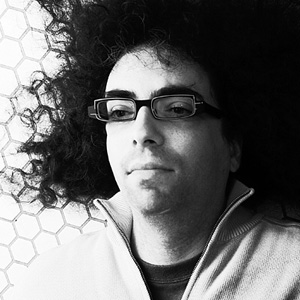We’re coming up on a really exciting show this Sunday at Constellation, where we launch our new concert initiative Currents. We’ll be premiering new works, and performing some other works that are new to us. The composers have some really deep and interesting stuff to say about their music, so we’re posting more detailed program notes on our blog this week than will be included in the program book at the show. Enjoy!

Mark Applebaum
Mark Applebaum- Straitjacket
(notes by the composer)
When Steve Schick asked me for a new work to be commissioned by the Banff Centre for the Roots and Rhizomes Percussion Residency I worried “What kind of percussion piece do you write for a percussionist who has done everything?” I’m still not sure what the proper answer is to this question. But along the way I thought about putting ontological pressure on the boundary conditions of the medium itself; I considered the idea of paradoxically expanding Steve’s seemingly comprehensive domain of musical experience through focused constraints; and I gravitated, perhaps habitually, toward a kind of super-disciplined absurdity—as if invoking a parallel world whose eccentric culture is governed by elaborate rules perceived but not understood. In short, I managed to compose Straitjacket, a provisional answer of sorts.
Straitjacket, privately subtitled “four restraint systems for solo percussion and percussion quartet,” intersects conceptually with formal techniques employed by the French literary group Oulipo: the palindrome, the isopangram, the lipogram, and the taquinoid.
Movement I- Palindrome
The palindrome reads the same forward and backward, as in “A man, a plan, a canal—Panama.” The first movement is scored for six drum sets played in unison and with excruciating fastidiousness (despite a profusion of metric modulations and abundant coordination challenges for the limbs), the quartet playing matched kits consisting of kick drum, snare, and hi-hat, the soloist playing two analogous kits with substitute timbres of the player’s choice. At the epicenter of the piece—its palindromic mirror— the soloist switches kits.
This palindrome, however, is a bit irregular. The first side is built up using a technique accurately, if pretentiously, dubbed sequential metamorphosis censorship. The scheme is mind-numbingly elaborate, but the gist is that the musical narrative gradually increases and decreases the degree to which adjacent musical materials are transformed. For example, the second measure is a clear modification of the first measure; however, the third measure is a bit more distant from the second, as if an intermediary transformative step were missing; and so on. The conceptual gap widens and narrows, producing moments of logical consequence as well as profoundly incongruous ones.
But when this sequence folds back on itself, only some of the prior measures are sounded. New measures appear instead (algorithmically selected among those unsounded, intermediary bits that conceptually bridged the earlier gaps). At the same time there exist other composed intermediary bits that are never sounded on either side of the mirror. Perhaps it is clearer to imagine that my tasks is to first compose a number series and its retrograde: 12345 – 54321. But then the palindrome is distilled: 125-541. As such, certain bits (1, 5) are heard in both directions; certain bits (2) are heard only forward; certain bits (4) are heard only in reverse; and certain bits (3) exist conceptually, but are never sounded. Consequently, discursive gaps of varying size abound, from the most gently evolving discourse to the most fractured and surreal.
Movement II- Isopangram
A pangram uses every letter in the alphabet at least once, as in “A quick brown fox jumps over the lazy brown dog.” Whereas this 38-character phrase repeats some letters, an isopangram uses each letter in the alphabet once and only once.
The second movement of Straitjacket replaces the notional alphabet with a lexicon of 118 hand gestures, a kind of index in which each gesture is performed by the soloist once and only once. (That is, material is invented and then explicated only one time, without the tedium of development.) These silent actions are precisely described in the score (each with a corresponding paragraph of detailed instructions in an eleven-page appendix) and arrayed in a carefully specified rhythm. Although silent, they are accompanied by a quartet of “foley artists” who give voice to the gestures through a battery of instrumental timbres, each heard exactly twice.
Movement III- Lipogram
In opposition to univocalism—in which a text is written with just one vowel, such as Georges Perec’s What a Man!, a short story using only the vowel “A”—the lipogram avoids a particular letter. The most arresting example is Perec’s astonishing novel La Disparition that manages to avoid the letter “E” throughout its several hundred pages (and whose translation into English by Gilbert Adair—A Void—is perhaps an even more remarkable feat). More concisely, Harry Matthews explains that the phrase “To be or not to be, that is the question” becomes, by way of lipogram in A, “To be or not to be, this is the question;” by way of lipogram in E it becomes “Survival or oblivion: that is our quandary;” and by way of lipogram in T it becomes “Being or non-being, such is my dilemma.”
To me the idea of avoidance conjured a corresponding musical act of removal. Hence, in the third movement the ensemble plays a single vibraphone, the quartet articulating unison chords and the soloist muting particular bars in an act of sonic elimination.
Movement IV- Taquinoid
A representational painting in the shape of a square, if cut into a matrix of smaller squares and reassembled in random order, would likely result in a jumbled meaning. But a taquinoid works in any ordering because each piece has a visual narrative that makes sense when extended to any adjacent neighbor.
In movement IV five pictures are drawn by the ensemble, their scrawling amplified by contact microphones attached to the easels. A visual continuity appears horizontally across the pictures (and if they were placed in a vertical column). Admittedly, the pictures are not optimized for just any order. However, a new accord emerges across all five pictures: the players have arrived at their unique pictures through a unison rhythm, a harmonized quantity (but not comportment) of visual strokes and dots.
***
Why must these program notes be so verbose, loquacious, effusive, and prolix? And why even tease the audience with program notes when they can’t hear any of this blather in the music? Paper or plastic?
These are good questions, an occasion to shift toward a more essential if prosaic matter: the composer wishes to express his deepest gratitude to Steven Schick for requesting, with characteristic verve and nerve, yet another new piece—the latest project over a multi-decade span of wonderfully collaborative and endlessly revitalizing musical high jinx; to Barry Shiffman for the invitation to Banff and the unwavering courage and intelligence to indulge such a fine summit of talented, forward-thinking, and passionate percussion wackos; to the Banff Centre for their interminable support, uncommon competence, and unquestioning empathy; and to the intrepid players of Straitjacket who have lent their enthusiastic moxie and assiduous attention to the enterprise of realizing idiosyncratic art.
PS—can a program note have a post-script?: If you should demand a metric by which to evaluate my music, the works always aspire to engender two questions—“What the hell was that?” and “Can I hear more?”




